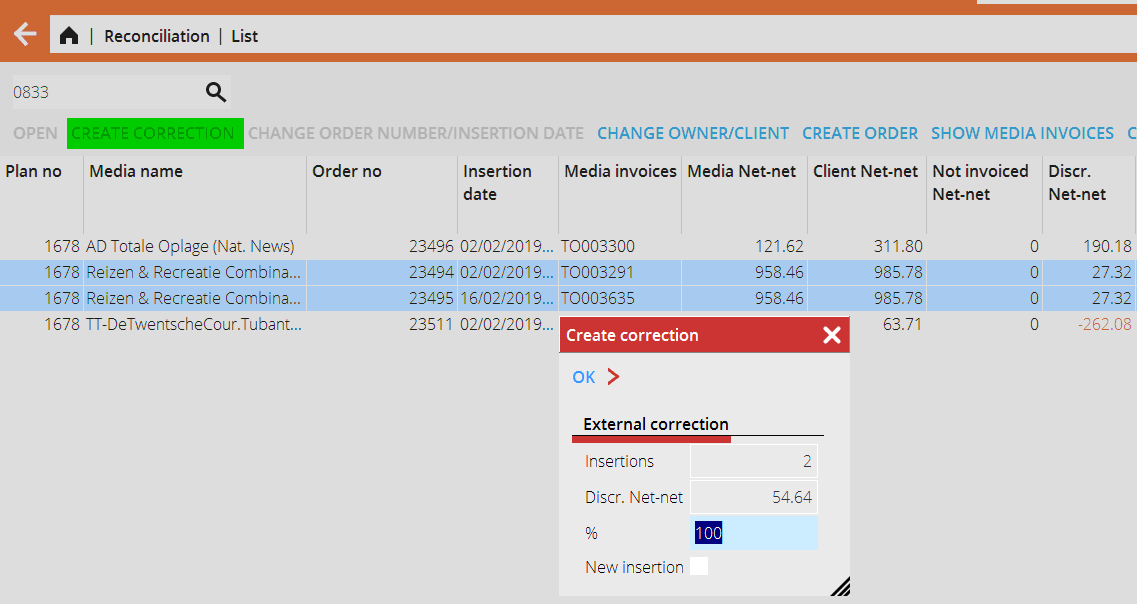Interne og eksterne korrektioner i Afstemningen
Contents
Interne og eksterne korrektioner i Afstemningen
Justeringer i afstemningen er en funktion til håndtering af differencer ved enten at flytte dele fra en indrykning til en anden eller automatisk at oprette nye indrykninger/priselementer. Begge metoder har den samme hovedfunktion, men bruges af forskellige årsager og fungerer på forskellige måder.
Eksterne korrektioner
Generelt
Eksterne korrektioner opretter et nyt priselement eller indrykning på den ordre, hvor der er en difference. Den nye indrykning kan derefter faktureres. Normalt bruges det, hvis mediet har sendt en korrekt faktura, og kunden skal faktureres for de ekstra omkostninger, eller i tilfælde hvor du har en aftale med kunderne om, at alle differencer skal returneres. Eksternt henviser i dette tilfælde til, at denne forskel skal udlignes ved at fakturere kunden det tilsvarende beløb.
Sådan gør du
- Gå til Media: Afstemning
- Vælg en eller flere indrykninger, som du vil rette.
- Angiv en procentdel, hvis kun en del af differencen skal flyttes til den nye priselement/indrykning (f.eks. hvis du har en aftale med kunden, der siger, at positive differencer skal deles mellem kunden og bureauet). Afkryds feltet "Indrykning" for at oprette en ny indrykning. Hvis feltet er tomt, oprettes der en ny indrykning på samme indrykning.
- Tryk på OK.
Når du derefter åbner en af de indrykninger, hvor korrektionen blev foretaget, enten via mediebudgetter eller ved at klikke på Åbn i afstemningslisten, kan du se, at der er oprettet et nyt priselement med differencens beløb.
Important to note here is that the new price row is marked as “External correction”, that is has status code U (definitive) and Invoice comment with reference to the earlier client invoice.
Internal corrections
General usage
Internal corrections are used to move amounts between insertions. Compared to external corrections here two price rows are created: one credit/debit row on the insertion we are moving from and one credit/debit row on the insertion we are moving to. Internal correction is internal in that regard that the CTC on both the from and to insertion will be the same, so the client will not pay anything nor get credited anything for this. However, the corrections still need to be invoiced to be booked correctly in G/L, but the internal correction invoice will be zero.
How to
- Go to Media: Reconciliation.
- Select the insertion that you want to make the correction for (note: internal corrections can only be made for one order at a time).
- Go to tab Internal correction, incl. client agreement. (NB internal corrections excl. client agreement is not in scope of this manual).
- Select which Order and insertion the amount should be moved to.
- Select the amount to be moved (default is the full net discrepancy).
- Click OK.
Opening the insertions, we can see the new price rows created by the correction: First order:
Second order:
Important to note here is that the credit and debit rows have the same CTC but different Net. This is because we in this case had different client agreements on these orders. The internal correction is then adjusting the Net amount to get to the same CTC. Also note the invoice comment where it’s shown which insertions where involved in this correction.
Invoicing corrections and additional functionality tied to corrections The corrections functionality described above is creating new price rows and insertions. These however must at some point be invoiced. In Media: Invoicing it is possible to make selections on correction status to either Blank (all insertions price rows regardless of correction status), Yes (only correction price rows are in the selection), No (no correction price rows are in the selection), Int (only internal corrections are in the selection).
The selection above is often combined with “Force one invoice per client” to invoice all corrections on one invoice. Especially for internal correction this is handy as the amount for those should be zero. Aside from the invoicing selections it’s also possible to include or exclude internal corrections in Media: Queries and to show corrected invoices in Media: Reconciliation.





